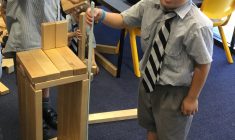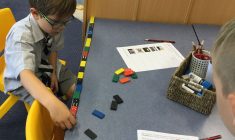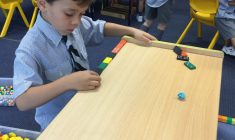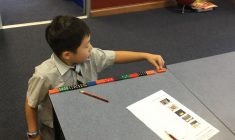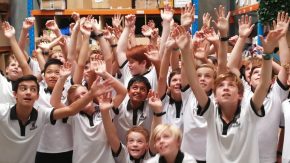Stage 1 – Year 1 – Measurement
Recently Year 1 has been a hub of mathematical investigation as the boys have launched into an inquiry unit into measurement; what it is, why accuracy is important and how measurement allows us to make and understand comparisons. In doing so they have delved into the mathematical strands of length, area, mass and volume and have gotten their hands dirty. No high minded theorising in textbooks, no these boys are at the very coalface of mathematical discovery.
In Year 1 outcomes the focus in measurement moves from directly comparing two items to see which is longer, bigger or heavier to indirect comparison through the use of uniform informal units. Uniform informal units can really be anything the boys choose so long as are all the same size. It is totally up to the boys to decide how useful or appropriate that unit is for the measurement they are engaging in.
Our unit has focused on a question, prediction, measure and conclude approach. The boys are given a question or challenge and they need to make predictions before using measurement to confirm their predictions. Some popular investigations have been ‘Who has the biggest head?’, ‘Who can make the biggest shape using 12 paddle pop sticks?’, “What mystery item is the same length as this bit of string?’.
Recently we tried to find out who had the biggest shoe. All the boys traced the outline of their right shoe into their books. I then asked them how could we find out who had the biggest shoe without putting them next to each other. Instantly there was a hum of discussion as boys shared their ideas with partners. What followed was an excellent discussion on the merits of different units for measuring area.
Oliver got the ball rolling by commenting ‘We need to all measure with the same unit, otherwise we won’t know how big our shoes are.’
Christian H suggested ‘We could measure them with dominoes, like we did for length!’ So we asked Christian to show us.
Then Sam noticed ‘The dominoes are too straight, we need a curved object like coins.’ So Sam got the coins and started measuring for the class.
He had barely measured half the shoe when Corbin declared ‘There are too many gaps in between the coins. There is too much space!’ He suggested unifix cubes and rushed to grab them.
He had just started to measure when Jamie pointed out that ‘The unifix cubes are still too big, they will hang over the edge. Centicubes would be better!’
So Jamie grabbed the centicubes and started lining them up inside the shoe. The boys certainly thought that they looked like the best option and so the measuring began. 15 minutes later and the boys declared in frustration that the centicubes were too small, took forever to measure and we didn’t have enough. To Corbin’s great delight we all decided that he was right all along and we should measure with unifix cubes.
This single 5 minute conversation highlights the understanding we want to impart on the boys. Firstly the need for accuracy when measuring is crucial, but secondly to understand the need for formal units of measurement that can be used based on the length, size, mass or volume of what you are measuring. By discussing the merits or limitations of different informal units the boys will appreciate the accuracy and ease of using formal units when they get to using them next year.
Angus Lawson – Classroom Teacher



